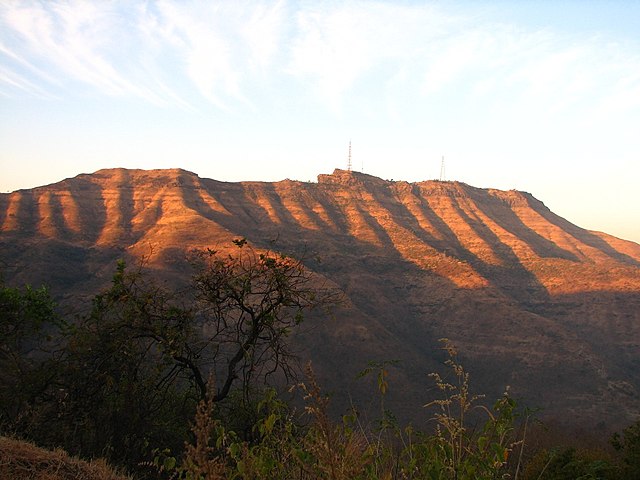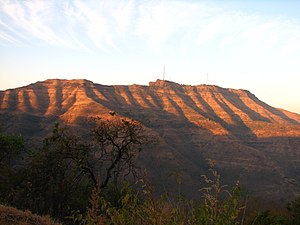Battle of Sinhagad
Contributors to Wikimedia projects
 Article Images
Article Images
The Battle of Sinhagad, also known as Battle of Kondhana, involved an attack by Marathas during the night of 4 February 1670 on the Mughal fort of Sinhagad (then Kondhana), near the city of Pune, Maharashtra. The Marathas captured the fort.
| Battle of Sinhagad (Kondhana) | |||||||||
|---|---|---|---|---|---|---|---|---|---|
| Part of The Maratha rebellion | |||||||||
 The Fort of Sinhagad | |||||||||
| |||||||||
| Belligerents | |||||||||
|
|
| ||||||||
| Commanders and leaders | |||||||||
|
|
| ||||||||
| Strength | |||||||||
| Unknown | Unknown | ||||||||
Background
In the 1650s, Aurangzeb sent Shaista Khan to subdue Shivaji. Khan captured Poona (now Pune) and took residence in Lal Mahal. Shivaji and his soldiers made a surprise attack on Khan, wherein they wounded him and killed one of his sons. However, Khan eventually escaped. Khan looted Pune for 2 years and devastated Deccan. So, Shivaji went on to loot and plunder the wealthy port city of Surat to restore the wealth as Surat at the time was a centre of great riches and wealthy merchants. This greatly increased Aurangzeb's anger against the Marathas. He sent his General Mirza Raja Jai Singh with a large army to subdue Shivaji. Jai Singh besieged Purandar fort. Meanwhile, Diler Khan defeated the armies at Vajragad, near Purandar. The Mughals plundered villages in the Maratha kingdom. For the welfare of his subjects, Shivaji decided to sign a treaty with Jai Singh. They met and signed the Treaty of Purandar. According to the treaty, Shivaji was to give 23 forts to the Mughals and agree to fight for them when needed. He would be allowed to retain control of 12 forts. Later, he agreed to meet Aurangzeb at Agra.[citation needed]
Upon reaching Agra, Aurangzeb put him under house arrest, but Shivaji managed to escape. Shivaji then kept a low profile for some years until Aurangzeb increased activities in the north. Later, Jai Singh died at Burhanpur, and a weaker prince, Muazzam, became governor of the Deccan. Shivaji then felt that this was a good opportunity gain territory. He broke the treaty and started recapturing the forts that he had previously given the Mughals under the treaty.[citation needed]
Battle
Tanaji Malusare, accompanied by a small contingent of Maratha troops, embarked on a daring night assault to reclaim Sinhagad Fort. The mission was fraught with peril, as the fort was heavily guarded by Mughal forces under the command of Udaybhan Rathod, a formidable warrior in his own right. Under the cover of darkness, Tanaji and his men scaled the steep and treacherous cliffs of the fort using innovative tactics and sheer determination. They encountered fierce resistance but managed to breach the fort's defenses. The battle was fierce and intense, with hand-to-hand combat being the order of the night. Tanaji Malusare led from the front, inspiring his troops with his bravery. The tide of the battle turned in favor of the Marathas due to their relentless assault and strategic prowess. Despite the overwhelming odds, Tanaji Malusare and his troops managed to secure the fort. However, Tanaji himself was mortally wounded in the final stages of the battle. His death was a profound loss for the Marathas, but his sacrifice became a symbol of ultimate bravery and dedication. The Marathas' victory at Sinhagad Fort was a significant morale booster for Shivaji Maharaj's forces and a critical setback for the Mughal Empire in their efforts to dominate the region. The recapture of the fort demonstrated the Maratha's tactical brilliance and their unwavering resolve to defend their sovereignty.[3]
Aftermath
When Shivaji was informed about the victory and the loss of Tanaji's life during the battle, he exclaimed "Gad aala pan sinh gela" (Devnagari: गड आला पण सिंह गेला) (English: "The fort has been captured but we lost the lion"). A bust of Tanaji Malusare was installed at the fort in memory of his contribution and sacrifice. The Battle of Sinhagad remains etched in the annals of history as a testament to Maratha valor and military strategy. Tanaji Malusare is celebrated as a hero, and his sacrifice is commemorated in various forms, including memorials and folklore. The battle also highlighted the strategic importance of Sinhagad Fort and its role in the broader conflict between the Maratha Empire and the Mughal Empire. In contemporary India, the story of the Battle of Sinhagad is often recounted as an example of courage, loyalty, and sacrifice. The fort itself stands as a monument to this historic confrontation, attracting visitors who seek to learn about and pay tribute to this pivotal moment in Indian history. In summary, the Battle of Sinhagad is not merely a historical event; it is a symbol of the Maratha Empire's resilience and the enduring spirit of its warriors. It underscores the profound impact of leadership, strategy, and valor in shaping the course of history.[4] The fort was also renamed Sinhagad to honour his memory.[citation needed]
In popular culture
- Tanhaji - a Hindi movie of 2020, starring Ajay Devgan, depicted the battle of Kondhana.
- Raja Shivchatrapati - a Marathi TV serial of Star Pravah had episodes about this battle.
- Subhedar - a Marathi movie of 2023, starring Chinmay Mandlekar, depicted the battle of Kondhana
References
- ^ Sorokhaibam, Jeneet (2013). Chhatrapati Shivaji: The Maratha Warrior and His Campaign. Vij Books India Private Limited. pp. 185–187. ISBN 9789382573494.
{{cite book}}: CS1 maint: date and year (link) - ^ Gordon, Stewart (February 2007). The Marathas 1600-1818. Cambridge University Press. ISBN 978-0-521-03316-9.
- ^ Gordon, Stewart (1993). The Marathas 1600-1818. Vol. 2. Cambridge University Press. p. 79. ISBN 9780521033169.
The first and most spectacular success was the capture of Sinhagad fort. It was taken by scaling very difficult walls by the means of rope ladders in a night raid which culminated in a hand to hand combat inside the fort. The raid was led by Tanhaji Malsure, who was killed in the battle.
- ^ Verma, Amrit (2003). Forts of India. New Delhi: The Director, Publication Division, Ministry of Information and Broadcasting, Government of India. pp. 83–86. ISBN 81-230-1002-8.